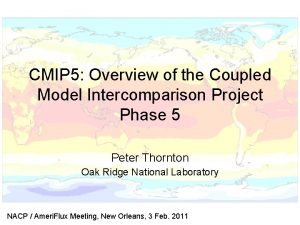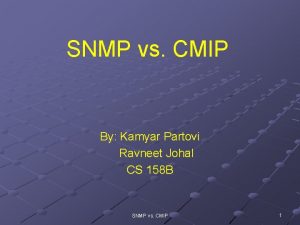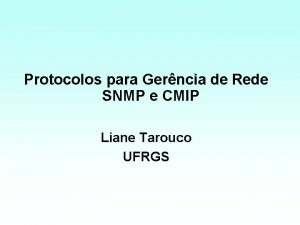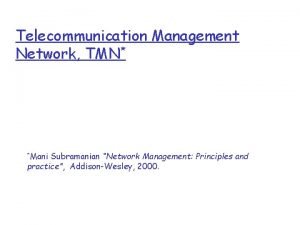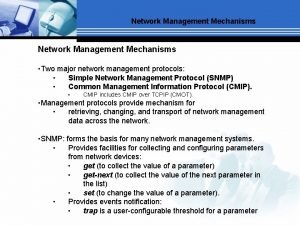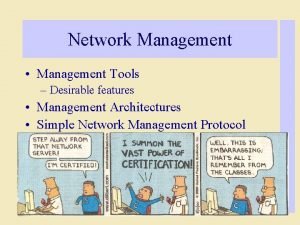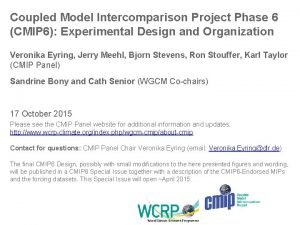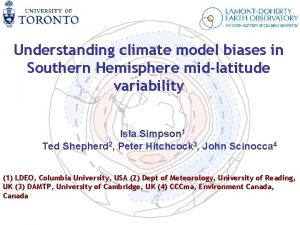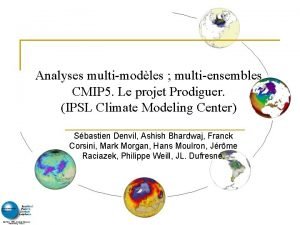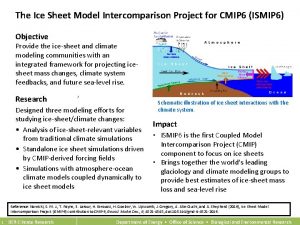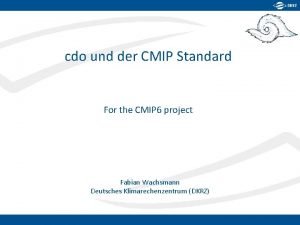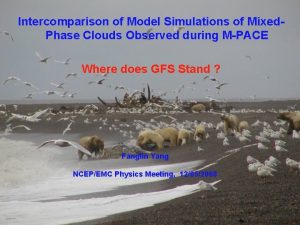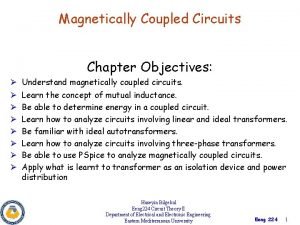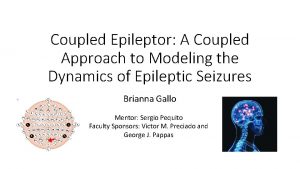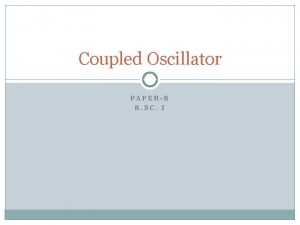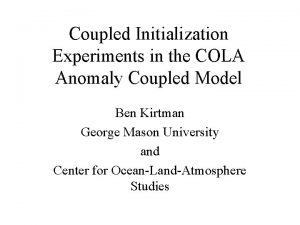Coupled Model Intercomparison Project Phase 6 CMIP 6













- Slides: 13

Coupled Model Intercomparison Project Phase 6 (CMIP 6): Experimental Design and Organization Veronika Eyring, Jerry Meehl, Bjorn Stevens, Ron Stouffer, Karl Taylor (CMIP Panel) Sandrine Bony and Cath Senior (WGCM Co-chairs) 18 October 2015 WGCM Meeting, Dubrovnik Please see the CMIP Panel website for additional information and updates: http: //www. wcrp-climate. org/index. php/wgcm-cmip/about-cmip Contact for questions: CMIP Panel Chair Veronika Eyring (email: Veronika. Eyring@dlr. de) The final CMIP 6 Design, possibly with small modifications to the here presented figures and wording, will be published in a CMIP 6 Special Issue together with a description of the CMIP 6 -Endorsed MIPs and the forcing datasets. This Special Issue will open ~April 2015.

Today’s and Tomorrow’s Agenda 1. 2. 3. 4. …. 5. Forcings Evaluation activities for CMIP 6 Data request Reports by the modelling groups Continued by Posters from each of the 21 CMIP 6 -Endorsed MIPs tomorrow Unique opportunity to have all these people in one room • Modelling group representatives • MIP co-chairs (1 from each MIP today; possibly more tomorrow) • Martin Juckes and WIP co-chairs (Data request) • WGCM members

Timeline Forcing Datasets • Initial description of each forcing dataset sent to CMIP Panel chair (Forcing Group, 31 January 2015) • Initial description reviewed (Model groups, 31 March 2015) • Description of forcing datasets in CMIP 6 Special Issue (Forcing Group, preferably by 31 December 2015) => now changed to March 2016 • Forcing datasets available (Forcing group, see next slide)

Finalize scenario choice, March 2015 (O’Neill, Tebaldi, van Vuuren) WGCM Jan 1 April July CMIP 6 1 st draft Review Design 2015 description 2015 forcings 2015 of forcings CMIP 6 Design Special Issue including forcing description Oct 2015 descriptions Jan 1 2016 PI/Historical SLCF emissions (S. Smith) Historical GHG emissions to 2014 (B. Andres) CMIP 6 Timeline April 2016 July 2016 Oct 2016 Jan 1 2017 Historical SLCF emissions with uncertainties, seasonality, + (S. Smith) = prototype ready Gridded GDP and population maps etc. (HYDE & IIASA website) Historical land use (G. Hurtt, D. Lawrence) = Pre-industrial ready Historical GHG concentrations (M. Meinshausen) Historical ozone concentrations (M. Hegglin, J. -F. Lamarque) Historical aerosol concentrations (B. Stevens) Solar past and future (K. Matthes, B. Funke) Volcanoes (L. Thomason et al. ) Future emissions (IAMs) Gridding & Harmonization past to future (IAMs) Future GHG concentrations (IAMs) Future ozone and aerosol concentrations (M. Hegglin, J. -F Lamarque, B. Stevens) Future harmonized land use dataset (G. Hurtt, D. Lawrence) PI control and idealized model experiments: DECK CMIP 6 Historical Simulation Scenario. MIP global model runs Nominal Period of CMIP 6 (2015 -2020)

Timeline Data Request

CMIP 6 -Endorsed Model Intercomparison Projects (MIPs) Ongoing Diagnosis, Evaluation, and Characterization of Klima (DECK) Experiments DECK (entry card for CMIP) i. AMIP simulation (~19792014) ii. Pre-industrial control simulation iii. 1%/yr CO 2 increase iv. Abrupt 4 x. CO 2 run CMIP 6 Historical Simulation (entry card for CMIP 6) v. Historical simulation using CMIP 6 forcings (1850 -2014) Note: The themes in the outer circle of the figure might be slightly revised at the end of the MIP endorsement process (DECK & CMIP 6 Historical Simulation to be run for each model configuration used in the subsequent CMIP 6 -Endorsed MIPs)

CMIP 6 -Endorsed MIPs and Model Groups’ Commitments to Participate in each MIP 0 5 10 15 25 13 Aer. Chem. MIP C 4 MIP Long Name of MIP (Short Name of MIP) Aerosols and Chemistry Model Intercomparison Project CFMIP 1 (Aer. Chem. MIP) DAMIP Coupled Climate Carbon Cycle Model Intercomparison Project DCPP 2 4 (C MIP) FAFMIP 3 Cloud Feedback Model Intercomparison Project (CFMIP) Geo. MIP Detection and Attribution Model Intercomparison Project 4 GMMIP (DAMIP) High. Res. MIP 5 Decadal Climate Prediction Project (DCPP) ISMIP 6 6 Flux-Anomaly-Forced Model Intercomparison Project (FAFMIP) LS 3 MIP 7 Geoengineering Model Intercomparison Project (Geo. MIP) LUMIP 8 Global Monsoons Model Intercomparison Project (GMMIP) 9 High Resolution Model Intercomparison Project (High. Res. MIP) OMIP 10 Ice Sheet Model Intercomparison Project for CMIP 6 (ISMIP 6) PMIP 11 Land Surface, Snow and Soil Moisture MIP (LS 3 MIP) RFMIP 12 Land-Use Model Intercomparison Project (LUMIP) Scenario. MIP 13 Ocean Model Intercomparison Project (OMIP) Vol. MIP 14 Paleoclimate Modelling Intercomparison Project (PMIP) CORDEX 15 Radiative Forcing Model Intercomparison Project (RFMIP) Dyn. Var 16 Scenario Model Intercomparison Project (Scenario. MIP) SIMIP 17 Volcanic Forcings Model Intercomparison Project (Vol. MIP) VIACS AB Coordinated Regional Climate Downscaling Experiment 18 (CORDEX) 20 19 19 14 17 10 10 20 15 11 13 13 21 14 11 23 11 13 13 17 14

CMIP 6 Status - Status and Outlook CMIP 6 Organization and Design finalized CMIP 6 MIP endorsement of April 2015 proposals finalized Timelines in place forcing datasets CMIP 6 Simulation Period (2016 -2020) Infrastructure in preparation (including data request) by WGCM Infrastructure Panel (WIP) CMIP 6 Participating Model Groups: > 30 using a hierarchy of models CMIP 6 Scenarios - New scenarios span the same range as the RCPs, but fill critical gaps for intermediate forcing levels and questions for example on short-lived species and land-use. A central goal of CMIP 6 is routine evaluation of the models with observations - Coordinated by the WGNE / WGCM climate diagnostics and metrics panel in collaboration with the CMIP Panel Workshops/meetings - 18 -20 October 2015: WGCM-19 (Dubrovnik, Croatia) 20 -23 October 2015: WCRP/FP 7 EMBRACE Workshop on CMIP 5 Model Analysis and Scientific Plans for CMIP 6 (Dubrovnik, Croatia) Geosci. Model Dev. Special Issue on CMIP 6 (July 2015 - December 2016) - Overview of the CMIP 6 Design and Organization (Eyring et al. , in prep, GMD, 2015) Experimental design from all CMIP 6 -Endorsed MIPs (submission by 31 March 2016) Description of the CMIP 6 forcing data Description of evaluation procedures (including obs 4 MIPs) and Infrastructure http: //www. wcrp-climate. org/index. php/wgcm-cmip/about-cmip

CMIP 6 Overview Paper 1. Background and motivation for new CMIP structure 2. Overview of Special Issue 3. Description of CMIP - DECK experiments with detailed description how Experiment CMIP 6 label Historical AMIP amip Pre-industrial control pi. Control 1 %/yr CO 2 1 pct. CO 2 Experiment Description Forcing methods CO 2 Observed SSTs and SICs concentrationprescribed driven CO 2 emission- Coupled atmosphere/ocean preor industrial control run concentration(concentration driven) driven CO 2 prescribed to increase at 1%/yr until concentrations have CO 2 quadrupled, and then concentration(optionally) extended 160 years driven with CO 2 concentration held constant Start Year End Year 1979 2014 36 Evaluation 1850 n/a 500 Evaluation, unforced variability 140 Climate sensitivity, feedbacks n/a Minimum # Major purpose Years Quadruple CO 2 abrupt 4 x. CO CO 2 abruptly quadrupled and abruptly, then 2 then held constant hold fixed CO 2 concentrationdriven n/a 150 Climate sensitivity, feedbacks, fast responses Past ~1. 5 centuries CO 2 emission- or concentrationdriven 1850 2014 165 Evaluation historical Simulation of the recent past

CMIP 6 Overview Paper 1. Background and motivation for new CMIP structure 2. Overview of Special Issue 3. Description of CMP - DECK - CMIP standardization, coordination, infrastructure, and documentation functions 4. Overview of CMIP 6 -Endorsed MIPs 1 Short name of MIP Aer. Chem. MIP 2 C 4 MIP Long name of MIP Primary Goal in CMIP 6 Aerosols and Chemistry Model Quantifying forcings, feedbacks and global-to-regional Intercomparison Project climate response from changes in near term climate forcers (NTCF) emissions (aerosols and ozone precursors) and reactive GHGs concentrations. Coupled Climate Carbon Cycle Understanding and quantifying future (century-scale) Model Intercomparison Project changes in land ocean carbon storage and fluxes. 21 VIACS AB => Please send us 1 -2 sentences on the goal of you MIP that you want to see in this table if possible by Friday lunch time

CMIP 6 Special Issue in GMD 1 2 3 4 5 6 7 8 9 10 11 12 13 14 15 16 17 18 19 20 21 22 23 24 25 26 27 28 29 30 31 32 33 34 35 CMIP 6 Experimental Design & Organisation Aer. Chem. MIP C 4 MIP CFMIP DAMIP DCPP FAFMIP Geo. MIP GMMIP High. Res. MIP ISMIP 6 LS 3 MIP LUMIP OMIP PMIP RFMIP Scenario. MIP Vol. MIP CORDEX* Dyn. Var* SIMIP* VIACS AB* Historical SLCF and GHG Emissions Global Gridded Land-use Forcing Datasets Historical GHG concentrations Ozone and Stratospheric Water Vapor Concentrations Aerosol Concentrations Solar forcing Stratospheric Aerosol Data Set Future Emissions AMIP SSTs and Sea Ice Datasets WGCM Infrastructure Panel (WIP) CMIP 6 Data Request WGNE/WGCM climate model diagnostics and metrics panel WDAC Task Team on Observations for Model Evaluation Overview CMIP 6 -Endorsed MIP CMIP 6 -Endorsed MIP CMIP 6 -Endorsed MIP CMIP 6 -Endorsed MIP CMIP 6 -Endorsed MIP CMIP 6 -Endorsed MIP Forcings DECK and Historical Simulation Forcings DECK and Historical Simulation Should be described in Scenario. MIP paper? Forcings DECK and Historical Simulation Infrastructure Model Evaluation

MIP Papers (1) • We are hoping that the GMD paper describing your MIP addresses all points of the application template and links clearly to one or more of the CMIP 6 scientific questions and the WCRP Grand Challenges. • that your paper covers the experimental design and scientific justification of each of the experiments in detail for Tier 1 (and possibly beyond), so that the groups actually find all the necessary information on why and how to run the experiment in your paper. • Detailed technical instructions could be moved to supporting material if required. • Your paper should also clearly make links from your experiments to the DECK and the CMIP 6 Historical Simulation which form the glue of our CMIP 6 multi-model, multiexperiment exercise. • It is expected that the MIPs also include a strong analysis plan to fully justify the resources used to produce the various requested variables. Further if the analysis plan is to compare model results to observations, please indicate what observations will be used, and whether the comparison entails any particular requirement for the simulations or outputs. • The forcings for the DECK and the CMIP 6 Historical Simulations will be described as well in the CMIP 6 Special Issue. Should you require additional forcings as part of your MIP experiments these would need to be created by your MIP and described in your GMD contribution.

MIP Papers (2) • We have chosen an open-discussion journal for the review process to allow for yet another entry point for the community to broadly review the specific design. – Should you receive comments on specific experiments that your author team finds worth considering, or receive otherwise important information, individual experiments can still change or be added. – If this results in a change to the Tier 1 experiments, this requires CMIP Panel approval. In addition, the modelling groups that participate in your MIP need to be informed and confirm that they would still run all of the Tier 1 experiments for a specific science question. – If this applies to Tier 2 or 3 experiments, the MIP endorsement criteria that relate to these experiments need to be fulfilled, in particular that the experiments are well-defined, useful in a multi-model context and don’t overlap with other CMIP 6 experiments. • All authors for GMD are expected to suggest 5 reviewers for each manuscript which the editor may, at their own discretion, use as a guide for inviting reviewers. For our GMD special issue on CMIP 6, the GMD chief-executive editor requests that the authors find at least one reviewer from their five suggestions who agrees beforehand to review the manuscript. The authors should state this person's name in the message to the editor. • In order to get the CMIP 6 design well-described in time for the modelling groups to prepare and start the runs, the deadline for the submission of the papers for the now endorsed MIPs is 31 March 2016.
